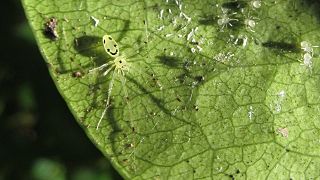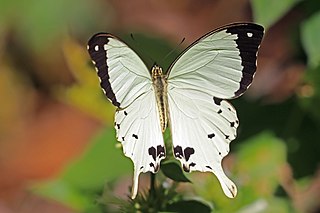
In evolutionary biology, mimicry is an evolved resemblance between an organism and another object, often an organism of another species. Mimicry may evolve between different species, or between individuals of the same species. Often, mimicry functions to protect a species from predators, making it an anti-predator adaptation. Mimicry evolves if a receiver perceives the similarity between a mimic and a model and as a result changes its behaviour in a way that provides a selective advantage to the mimic. The resemblances that evolve in mimicry can be visual, acoustic, chemical, tactile, or electric, or combinations of these sensory modalities. Mimicry may be to the advantage of both organisms that share a resemblance, in which case it is a form of mutualism; or mimicry can be to the detriment of one, making it parasitic or competitive. The evolutionary convergence between groups is driven by the selective action of a signal-receiver or dupe. Birds, for example, use sight to identify palatable insects and butterflies, whilst avoiding the noxious ones. Over time, palatable insects may evolve to resemble noxious ones, making them mimics and the noxious ones models. In the case of mutualism, sometimes both groups are referred to as "co-mimics". It is often thought that models must be more abundant than mimics, but this is not so. Mimicry may involve numerous species; many harmless species such as hoverflies are Batesian mimics of strongly defended species such as wasps, while many such well-defended species form Müllerian mimicry rings, all resembling each other. Mimicry between prey species and their predators often involves three or more species.

In biology, polymorphism is the occurrence of two or more clearly different morphs or forms, also referred to as alternative phenotypes, in the population of a species. To be classified as such, morphs must occupy the same habitat at the same time and belong to a panmictic population.
Frequency-dependent selection is an evolutionary process by which the fitness of a phenotype or genotype depends on the phenotype or genotype composition of a given population.
Balancing selection refers to a number of selective processes by which multiple alleles are actively maintained in the gene pool of a population at frequencies larger than expected from genetic drift alone. Balancing selection is rare compared to purifying selection. It can occur by various mechanisms, in particular, when the heterozygotes for the alleles under consideration have a higher fitness than the homozygote. In this way genetic polymorphism is conserved.

Batesian mimicry is a form of mimicry where a harmless species has evolved to imitate the warning signals of a harmful species directed at a predator of them both. It is named after the English naturalist Henry Walter Bates, after his work on butterflies in the rainforests of Brazil.

Anti-predator adaptations are mechanisms developed through evolution that assist prey organisms in their constant struggle against predators. Throughout the animal kingdom, adaptations have evolved for every stage of this struggle, namely by avoiding detection, warding off attack, fighting back, or escaping when caught.

The viceroy is a North American butterfly. It was long thought to be a Batesian mimic of the monarch butterfly, but since the viceroy is also distasteful to predators, it is now considered a Müllerian mimic instead.

Müllerian mimicry is a natural phenomenon in which two or more well-defended species, often foul-tasting and sharing common predators, have come to mimic each other's honest warning signals, to their mutual benefit. The benefit to Müllerian mimics is that predators only need one unpleasant encounter with one member of a set of Müllerian mimics, and thereafter avoid all similar coloration, whether or not it belongs to the same species as the initial encounter. It is named after the German naturalist Fritz Müller, who first proposed the concept in 1878, supporting his theory with the first mathematical model of frequency-dependent selection, one of the first such models anywhere in biology.

Ant mimicry or myrmecomorphy is mimicry of ants by other organisms. Ants are abundant all over the world, and potential predators that rely on vision to identify their prey, such as birds and wasps, normally avoid them, because they are either unpalatable or aggressive. Spiders are the most common ant mimics. Additionally, some arthropods mimic ants to escape predation, while others mimic ants anatomically and behaviourally to hunt ants in aggressive mimicry. Ant mimicry has existed almost as long as ants themselves; the earliest ant mimics in the fossil record appear in the mid Cretaceous alongside the earliest ants. Indeed one of the earliest, Burmomyrma, was initially classified as an ant.

Theridion grallator, also known as the Hawaiian happy-face spider, is a spider in the family Theridiidae that resides on the Hawaiian Islands. T. grallator gets its vernacular name of "Hawaiian happy-face spider" from the unique patterns superimposed on its abdomen, specifically those that resemble a human smiling face. T. grallator is particularly notable because of its wide range of polymorphisms that may be studied to allow a better understanding of evolutionary mechanisms. In addition to the variety of color polymorphisms present, T. grallator demonstrates the interesting quality of diet-induced color change, in which its appearance temporarily changes as it metabolizes various food items.
Prey detection is the process by which predators are able to detect and locate their prey via sensory signals. This article treats predation in its broadest sense, i.e. where one organism eats another.

Aggressive mimicry is a form of mimicry in which predators, parasites, or parasitoids share similar signals, using a harmless model, allowing them to avoid being correctly identified by their prey or host. Zoologists have repeatedly compared this strategy to a wolf in sheep's clothing. In its broadest sense, aggressive mimicry could include various types of exploitation, as when an orchid exploits a male insect by mimicking a sexually receptive female, but will here be restricted to forms of exploitation involving feeding. For example, indigenous Australians who dress up as and imitate kangaroos when hunting would not be considered aggressive mimics, nor would a human angler, though they are undoubtedly practising self-decoration camouflage. Treated separately is molecular mimicry, which shares some similarity; for instance a virus may mimic the molecular properties of its host, allowing it access to its cells. An alternative term, Peckhamian mimicry, has been suggested, but it is seldom used.
Prey switching is frequency-dependent predation, where the predator preferentially consumes the most common type of prey. The phenomenon has also been described as apostatic selection, however the two terms are generally used to describe different parts of the same phenomenon. Apostatic selection has been used by authors looking at the differences between different genetic morphs. In comparison, prey switching has been used when describing the choice between different species.

Papilio dardanus, the African swallowtail, mocker swallowtail or flying handkerchief, is a species of butterfly in the family Papilionidae. The species is broadly distributed throughout Sub-Saharan Africa. The British entomologist E. B. Poulton described it as "the most interesting butterfly in the world".

Chemical mimicry is a type of biological mimicry, involving the use of chemicals to dupe an operator. A chemical mimic dupes an operator by showing an adaptive chemical resemblance to an object of its environment and as a consequence receives selective advantage. In all cases of chemical mimicry it has been found that the mimicking species is the only species to benefit from the reaction with either costs or no effect on the duped species. This is by adapting to produce chemicals that will cause a desirable behavioural reaction in the species being deceived and a selective advantage to the mimic. Chemical mimicry exists within many of the different forms of mimicry such as aggressive, protective, Batesian, and Müllerian mimicry and can involve a number of different senses. Mimicking semiochemicals make up some of the most widely used forms of chemical mimicry, but is less apparent than more visual forms. As a result, this topic has been relatively neglected in research and literature. Two examples of organisms displaying chemical mimicry are: the mimicking of Noctuid pheromones by bolas spiders to lure prey; and the duping of insects within their own nests by mimicking their odours in order to enter and hide within the nest undetected.
Many types of polymorphism can be seen in the insect order Lepidoptera. Polymorphism is the appearance of forms or "morphs" differing in color and number of attributes within a single species. In Lepidoptera, polymorphism can be seen not only between individuals in a population but also between the sexes as sexual dimorphism, between geographically separated populations in geographical polymorphism and also between generations flying at different seasons of the year. It also includes the phenomenon of mimicry when mimetic morphs fly alongside non-mimetic morphs in a population of a particular species. Polymorphism occurs both at a specific level with heritable variation in the overall morphological design of individuals as well as in certain specific morphological or physiological traits within a species.
Insects have a wide variety of predators, including birds, reptiles, amphibians, mammals, carnivorous plants, and other arthropods. The great majority (80–99.99%) of individuals born do not survive to reproductive age, with perhaps 50% of this mortality rate attributed to predation. In order to deal with this ongoing escapist battle, insects have evolved a wide range of defense mechanisms. The only restraint on these adaptations is that their cost, in terms of time and energy, does not exceed the benefit that they provide to the organism. The further that a feature tips the balance towards beneficial, the more likely that selection will act upon the trait, passing it down to further generations. The opposite also holds true; defenses that are too costly will have a little chance of being passed down. Examples of defenses that have withstood the test of time include hiding, escape by flight or running, and firmly holding ground to fight as well as producing chemicals and social structures that help prevent predation.

Frequency-dependent foraging is defined as the tendency of an individual to selectively forage on a certain species or morph based on its relative frequency within a population. Specifically for pollinators, this refers to the tendency to visit a particular floral morph or plant species based on its frequency within the local plant community, even if nectar rewards are equivalent amongst different morphs. Pollinators that forage in a frequency-dependent manner will exhibit flower constancy for a certain morph, but the preferred floral type will be dependent on its frequency. Additionally, frequency-dependent foraging differs from density-dependent foraging as the latter considers the absolute number of certain morphs per unit area as a factor influencing pollinator choice. Although density of a morph will be related to its frequency, common morphs are still preferred when overall plant densities are high.
In evolutionary biology, mimicry in vertebrates is mimicry by a vertebrate of some model, deceiving some other animal, the dupe. Mimicry differs from camouflage as it is meant to be seen, while animals use camouflage to remain hidden. Visual, olfactory, auditory, biochemical, and behavioral modalities of mimicry have been documented in vertebrates.










